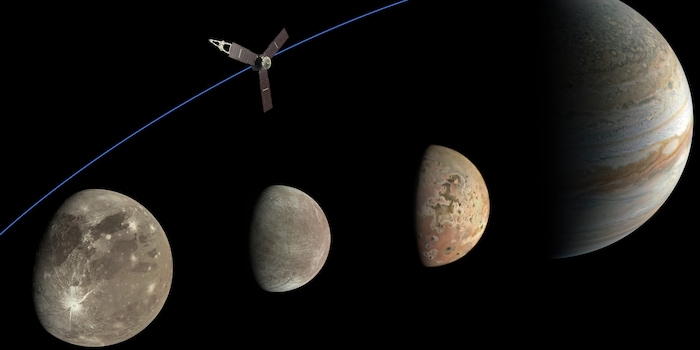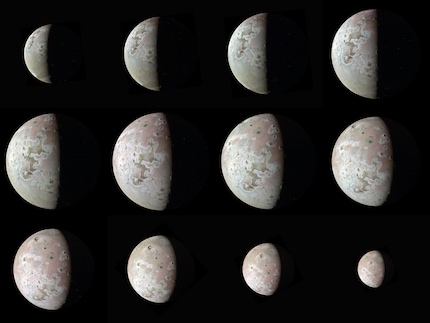
Juno space probe: Jupiter's moon Io on sale
Io, the innermost of Jupiter's four large satellites, is only slightly larger than our moon. Instead of a dead cratered desert like its Earth companion, Io offers a constantly changing landscape characterised by active volcanoes.
On its 53rd orbit around the giant planet Jupiter, the NASA space probe Juno came within 22,000 kilometres of Io, the innermost of the four large Galilean moons, on 30 July 2023. It took 15 images of the volcanically active moon with the JunoCam camera. The best images achieve a spatial resolution of 15 kilometres per pixel. They show the surface of Jupiter's satellite, which at 3643 kilometres in diameter is slightly larger than our moon, coloured by sulphur compounds.
There are no impact craters on Io; the entire surface is extremely young in geological terms. At least 200 volcanoes are active on Io at any one time, significantly more than on Earth. The volcanoes bring basaltic lava to the surface at high temperatures that are only reached on Earth in exceptional cases. The highest lava temperatures measured on Io to date have reached up to 1500 degrees Celsius - terrestrial basalts are usually between 1100 and 1200 degrees Celsius.
The reason for the extreme volcanic activity is the tidal friction caused by Jupiter and the neighbouring moons Europa and Ganymede. Actually, 4.5 billion years after its formation, Io should be as geologically inactive as our moon, which has a heavily cratered surface of great age. The reason why this is not the case is that Io is located deep in the gravitational field of Jupiter, by far the most massive planet in the solar system. It orbits Jupiter on an orbit that is only slightly closer than our moon orbits the Earth, but only takes 42 hours instead of around 29 days.

Source: NASA/SWRI /MSSS/Jason Perry
Jupiter's gravity deforms Io, creating tidal mountains up to half a kilometre high in the solid rock. By comparison, the moon and sun trigger tidal mountains only half a metre high in the solid Earth. The deformation of Io due to Jupiter's gravity would not actually have any drastic consequences because the moon rotates in a bound manner and always turns the same side towards its parent planet, just as our moon does towards the Earth. However, the gravitational fields of the two neighbouring moons Europa and Ganymede ensure that Io is repeatedly deflected from its resting position, causing the tidal mountains to move back and forth.
Europa and Ganymede are in orbital resonance with Io. Europa takes exactly twice as long to orbit Jupiter as Io, Ganymede four times as long. As a result, Io is regularly deflected from its rest position. This results in enormous frictional forces in the rock, which are so high that a large part of the mantle beneath the solid crust is melted. However, the crust of the satellite is stable enough for mountains to rise more than ten kilometres above the surrounding area. They are not volcanoes and consist of silicate rocks. Sulphur, on the other hand, would literally melt away.
Juno's next flyby of Io will take place on 15 October 2023, when the probe will come within 11,600 kilometres of Io. At the end of the year, a passage at a distance of only 1500 kilometres is planned - then there should be ultra-sharp images.
Spectrum of Science
We are partners of Spektrum der Wissenschaft and want to make well-founded information more accessible to you. Follow Spektrum der Wissenschaft if you like the articles.
[[small:]]
Cover image: NASA/JPL-Caltech/SwRI/MSSS
Experts from science and research report on the latest findings in their fields – competent, authentic and comprehensible.